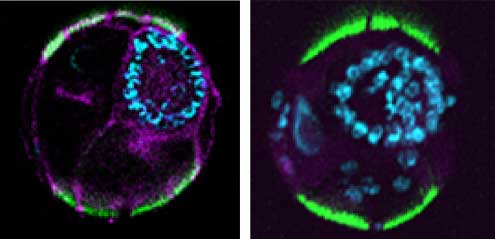| RIKEN Center for Developmental Biology (CDB) 2-2-3 Minatojima minamimachi, Chuo-ku, Kobe 650-0047, Japan |
Ihara and Nishiwaki began their study by addressing the question of whether MIG-17 localization to the DTC surface is truly a requirement for normal migration. (This had been assumed to be the case, but had never been directly shown.) Using a membrane-bound version of the protein, they showed that the DTC surface is indeed its primary site of action. The next followed up on a lead that had emerged from previous work by the Nishiwaki lab, which had showed that MIG-17 localization relied on a form of protein modification called glycosylation mediated by a second protein, MIG-23. By comparing DTC migration in wildtype and mutant worms carrying defects in MIG-17 glycosylation sites, they developed a model for the role of this modification by MIG-23 in which MIG-17 produced in the body wall muscle cells is glycosylated in the secretory pathway, enabling its homing to the DTC surface. Focusing on the details of MIG-17 protein structure, they analyzed the nine candidate glycosylation sites (six in a region known as the prodomain, and three in the MP domain) to determine which were involved in gonadal localization, and found that a subset of the prodomain sites were essential. Extending their analysis, they studied worms with mutations in each of the known MIG-17 domains, and concluded that the prodomain is necessary, but not sufficient, for normal DTC migration. Most other members of the ADAMTS family undergo a cleavage between the prodomain and the MP domain during the process of secretion; this cleavage, however, is dependent on other processing enzymes. Interested to find out if this was the case for MIG-17 as well, Ihara and Nishiwaki created an in vitro assay to study prodomain processing, and found that the cleavage of the prodomain was dependent on autocatalytic cleavage mediated by MIG-17’s own protease activity.By engineering mutant constructs of the protein to lack this function, they determined that prodomain processing is essential for gonadal migration in vivo as well. These latest findings from the Nishiwaki lab point to an unanticipated role for the prodomain in ADAMTS recruitment and function. Although previous reports had indicated a role for the prodomain in maintaining enzymatic latency, protein folding or secretion, the Ihara and Nishiwaki study showed that the MIG-17 prodomain is also crucial in the targeting of that protein to the gonad. Whether this is true in other ADAMTS proteins remains to be seen, but the fact that some of them are also secreted into the extracellular space as pro-enzymes having prodomains makes this an intriguing possibility. As ADAMTS is a protein family of recognized medical importance, these new insights are sure to be of interest to basic and clinical researchers alike. TheC. elegans MIG-17 system is the only available platform in which the spatial-temporal action of an ADAMTS can be monitored during organ morphogenesis in living animals, which the Nishiwaki team has deftly exploited in demonstrating a novel function of the prodomain required for targeting MIG-17 to the gonad. “Because ADAMTS enzymes are secreted proteins that must be brought to their target tissues during development, it is possible that prodomain targeting is one of the key strategies employed by ADAMTS proteins to localize to specific tissues where they function in organogenesis,” notes Nishiwaki, highlighting the potentially broad impact of this work.
|
|||||
|
|||||
 |
| Copyright (C) CENTER FOR DEVELOPMENTAL BIOLOGY All rights reserved. |
